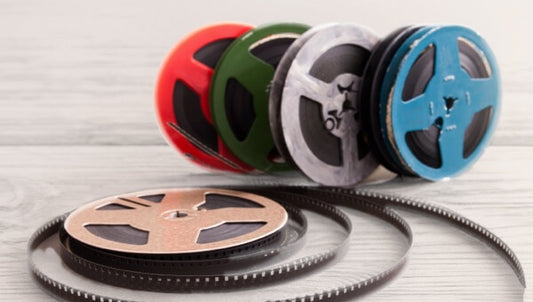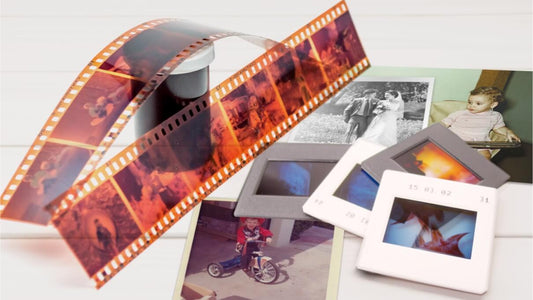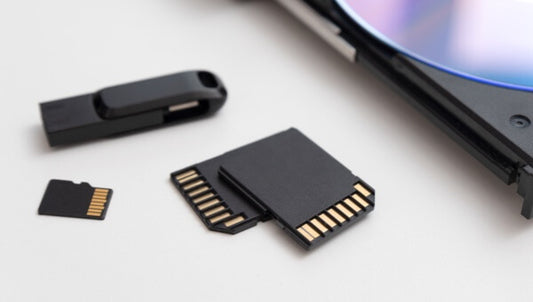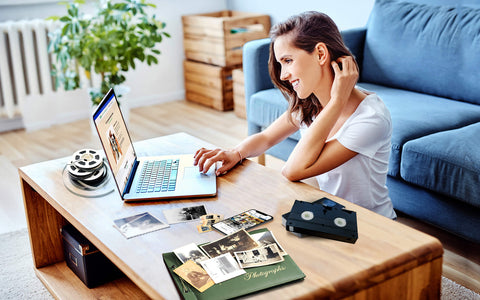Projectors have been around for decades, helping us share memories, watch movies, deliver presentations, and more. Whether you’re loading a classic slide carousel or streaming from a laptop, all projectors follow the same basic principle: they take an image and throw it onto a larger screen or surface. But how do projectors actually work? What types are there? And how do old film and slide projectors compare to modern digital ones? In this guide, Capture explains how projectors work step by step - from light sources and lenses to the differences between analog and digital projection.
Jump To:
- What Is a Projector and What Does It Do?
- How Do Projectors Work Step by Step?
- What Are the Main Parts of a Projector?
- The Different Types of Projectors
- How Do Different Types of Projectors Work?
- Advantages and Disadvantages of Projectors
- How to Choose the Right Projector
- How to Maintain and Care for Your Projector
- Bring Your Memories to Life on the Big Screen
What Is a Projector and What Does It Do?
A projector is a device that takes an image or video and projects it onto a larger screen or surface. This can be done using either analog film, photographic slides, or digital input from a computer, DVD, or streaming device.
Projectors are used for:
- Home entertainment (movies, games, sports)
- Business presentations
- Classroom teaching
- Viewing old slides and films
The goal is always the same: to make the image bigger, more shareable, and easier to enjoy with a group.

How different projectors work depends on the light source, image format, and projection technology they use.
How Do Projectors Work Step by Step?
While there are different types of projectors, the general process looks like this:
- Image Source: The source could be a film reel, photographic slide, or digital file (such as HDMI, USB, or VGA). This is the content to be displayed.
- Light Source: A powerful lamp (like halogen, UHP, xenon, or LED) or laser provides the bright white light needed for projection.
- Color and Image Formation: In digital projectors, the white light is split into red, green, and blue (RGB) components using color wheels, prisms, or individual LEDs/lasers. These colors are combined to form a full-color image. LCD and DLP projectors shape the light using liquid crystal panels or micromirrors.
- Optics and Filtering: The image is focused and resized using precision lenses. These lenses determine how far the image is thrown and how sharp it appears.
- Projection: The shaped and colored light is projected onto a screen or surface, displaying the final image for viewing.
The exact components and sequence may vary depending on whether you're using a film projector, a slide projector, or a modern digital projector.
What Are the Main Parts of a Projector?
Regardless of the format, projectors generally include the following components:
- Lamp or LED Light: Provides the brightness needed to display an image clearly.
- Lens: Focuses and magnifies the image for display.
- Cooling System: Keeps the internal parts from overheating.
- Optical Components: Like mirrors, prisms, or LCD panels that control how the image is formed.
- Input System: Accepts the image signal (analog or digital).
In older slide projectors, you’ll also find a slide tray or carousel to hold and rotate slides.

Most projectors have a light source, mirrors or LCD panels, and a lens.
The Different Types of Projectors
There are several types of projectors, each designed for different image sources and viewing needs. The most common types include:
Digital Projectors
- Widely used for home theaters, offices, and classrooms.
- Includes technologies like LCD, DLP, and LCOS.
Slide Projectors
- Designed to project 35mm photographic slides.
- Popular for personal, educational, and archival presentations.
Film Projectors
- Used to display motion picture film reels, including 8mm, 16mm, and 35mm formats.
- Found in movie theaters and vintage home cinema setups.
Overhead Projectors (OHP)
- Project images from transparent sheets placed on a glass stage.
- Common in older classroom and business settings.
LED and Laser Projectors
- A subset of digital projectors that use solid-state light sources.
- Known for long lifespans, lower heat output, and vibrant colors.
Smart Projectors
- Include built-in apps, Wi-Fi, and Bluetooth.
- Often portable and designed for wireless streaming and presentations.
How Do Different Types of Projectors Work?
While each projector uses an ambient light source and lens, the way they create the image can vary greatly. That’s why it’s important to look at how a movie projector works depending on the type of projector, which will give you more information to decide on the best projector for your purposes.
LCD Projectors
LCD projectors, or liquid crystal display projectors, use three panels made out of glass and liquid crystal as well as three standard mirrors and two dichroic mirrors. LCD projectors work by passing white light through the dichroic mirrors that reflect onto one wavelength to split the colors into red, green, and blue light. These colors are reflected onto the three LCD panels composed of thousands of tiny pixels to bring them back together into a single image.
The result is the ability to produce millions of colors out of RGB that offers exceptional color saturation. LCD projectors are known for their brightness and high-quality images at an affordable price. However, they can be a little harder to maintain and are bulkier than some newer projector technology.
DLP Projectors
Digital light processing projectors, or DLP projectors, were developed in the 1980s by Texas Instruments and can produce 35 million colors, which is more than the human eye. They use digital micromirror device (DMD ) chips that are made of millions of tiny micromirrors. The higher the number of micromirrors in the chip, the higher the pixels and the better the viewing experience.
They also use a color wheel to reflect white light onto the chips and the tiny mirrors blend the colors depending on the video or image source. DLP projectors are more expensive but produce high-quality images and superior picture quality. They are also light, reliable, and portable.
CRT Projectors
Cathode ray tube projectors, or CRT projectors, are also known as gun projectors and are the oldest type of screen projectors. They use the same technology as CRT TVs and generate images with a magnifying lens and three cathode ray tubes organized like RGB traffic lights. These lights will combine on a phosphor-coated surface to produce the image.
While CRT projectors may not produce a high-definition projected image, they are typically known for being durable, long-lasting, and affordable. However, they will not work for ultra-short throw purposes, which means you don’t want to get them for a small conference room. If you have a big screen size, though, they are worth a shot.
LED Projector
LED projectors can be a type of LCD or DLP projector, but they use light-emitting diodes, or LEDs, to produce the light instead of traditional projector lamps or light bulbs. Other than that, an LED projector will still have to use the same technology as a DLP or LCD projector.
Laser Projectors
Similar to LED projectors, the term laser projector refers to the light source, not the projector technology. Instead of using a light bulb or LED lights, a laser projector will use a laser. Then, they can use DLP, LCD, or LCOS technology.
LCOS Projectors
Liquid crystal on silicon or LCOS projectors are the newest type of projectors on the market. They use silicon instead of mirrors like DLP projectors. The beam of light is split into red, blue, and green using dichroic mirrors, similar to an LCD projector. The filtered lights are combined using a prism and passed through the lens and onto a screen.
LCOS video projectors are known for offering incredible image quality and contrast ratio without producing a “rainbow effect” that’s the result of the single chip or spinning color wheel found in other types. In fact, most 4K home theater projectors use LCOS technology. However, some people still prefer DLP projectors for fast motion videos because of the potential blur.

Projectors let you adjust screen size to fit your room and viewing needs.
Pico Projectors
Pico projectors are mini or micro projectors. They are light, portable, and compact, which means you can take them anywhere. While they can work okay in a very dark room as short-throw projectors and are certainly nifty gadgets, they are limited in well-lit areas, outdoors, or for big screen viewing. Furthermore, the built-in batteries can die fast, but some plug into an HDMI or USB for longer life.
Slide and Film Projectors
Finally, there are the traditional slide and film projectors that project light directly through your memories. While generally replaced by the other types of projectors, these will be the only type you can use to view your precious analog memories. They are fun and affordable, but harder to maintain.
If you plan on using a slide or film projector, we recommend converting your film reels or 35mm slide to digital first just to make sure they are never lost.
Advantages and Disadvantages of Projectors
Projectors offer some distinct advantages, but there are also disadvantages to consider, particularly with some projector types.
Benefits of Using Projectors
- Customizable screen size: Projectors let you scale your image to fit different spaces, from small walls to large projection screens.
- Portability: Most modern projectors are lightweight and compact, making them easier to move or travel with compared to large TVs.
- Eye comfort: Many people find projected images easier on the eyes than harsh TV backlighting, especially in dim rooms.
- Affordability and value: Compared to large-format televisions, projectors often provide more screen real estate for the price.
- High-resolution display: With the right setup and conditions, projectors can produce clear, detailed, high-quality images.
- Flexible features: Some models offer adjustable focus, lens swapping, wireless streaming, and zoom to suit different needs.
Limitations of Projectors
- Need for a projection surface: A flat, white screen (or wall) is essential to get the best visual experience. Textured or colored walls reduce clarity and color accuracy.
- Sensitivity to ambient light: Projectors work best in dark environments. Too much natural or artificial light can wash out the image.
- Throw distance and space limitations: Not all projectors work well in every room. Some are designed for ultra-short throws, while others need more space between the projector and screen.
- Setup and maintenance: While generally low-maintenance, projectors require occasional bulb replacements, filter cleaning, and setup calibration.
How to Choose the Right Projector
When shopping for a projector, keep the following factors in mind:
- Resolution – For family movies, photo slideshows, or presentations with detailed visuals, go for at least 1080p or higher.
- Brightness (lumens)– Choose a brighter projector (2,000+ lumens) for rooms with ambient light.
- Throw distance– Match the throw ratio to the room’s size. Ultra-short throw projectors work well in tight spaces.
- Portability – If you need to move the projector frequently, prioritize size and weight.
- Built-in features – Look for extras like Bluetooth, Wi-Fi, speakers, zoom, and lens shift.
Also consider your budget and brand preference. While budget projectors can offer decent quality, top-tier brands like Epson, Sony, and Canon are known for reliability and long-term performance.

Choose a projector based on resolution, brightness, and throw distance.
How to Maintain and Care for Your Projector
To keep your projector working well for years, basic care and maintenance are key.
Maintenance Tips
- Follow the manual: Make sure there’s enough space around the fan to prevent overheating.
- Power down when not in use: Turning off the projector when idle helps extend lamp life.
- Clean the lens: Use a microfiber cloth to gently wipe the lens for a sharper image.
- Check air filters: Dust buildup can block airflow. Clean filters regularly to prevent overheating.
- Replace the lamp on time: Most projectors will notify you when it’s time to change the bulb. Keep a spare on hand.
Common Fixes
- Blurry or discolored images: Clean the lens, adjust focus, and check color settings.
- Overheating issues: Ensure proper ventilation and clean any dust near fans or filters.
With just a little upkeep, your projector can deliver clear, bright images for many years.
Bring Your Memories to Life on the Big Screen
Now that you know how a projector works with a phone, memory card, computer connection, or even analog slides and film, you can start viewing your precious memories, movies, and more! Just make sure you consider the screen size, room size, darkness, resolution, and other factors to choose the best type for you. While CRT projectors are cheaper, LCD and, especially, LCOS and DLP will offer higher resolution.
To display your most precious photos, home movies, slides, film, and more using a digital projector, choose Capture to digitize your memories. Whether you want to convert slides to digital for easier viewing or preserve your family history for generations, Capture makes the process simple, safe, and high-quality.











